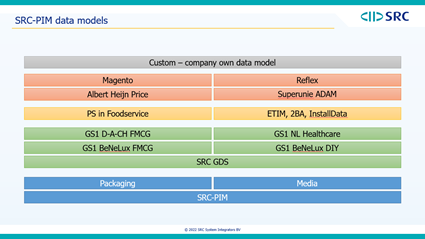In our latest blog we discussed the standard data models of SRC-PIM. Besides these SRC-PIM standard data models a company can create its own “custom” data model. This custom data model can be stand-alone or an add-on to one of the standard data models.
A custom data model can contain the same functionality as the standard data models. So you can define your own attributes, attribute forms, code lists, contexts, validations, etc.
When configuring the custom data model you can set one or more dependencies of standard data models. This enables you to use the available attributes from that model in the custom data model in attribute forms, validations, contexts or use code lists from the standard data model. This enables you to build your own attribute forms in the desired lay-out with the set of attributes that is relevant for your company. You can build additional validations or define additional contexts on top of the standard model. This together can provide a more tailored experience for your company.

A dependency of a standard data model is not mandatory within a custom data model. You can also build a stand-alone custom data model. Within such a custom data model you define your own attributes, code lists, validations, contexts and/or attribute forms. With such a custom data model you can fully customize the PIM experience for your company and tailor it to your needs.
To summarize these are the most used options within a custom data model.
- Custom data model with dependencies
- Create own attribute forms with selection of standard attributes and lay-out;
- Store additional attributes on top of standard data model to synchronize item data with other systems than the data pool, like website, ERP, etc.;
- Add additional validations on top of standard data model to make sure the data quality is right for certain customers that use that data pool or for certain external systems like website, ERP, etc.;
- Add additional code list attribute but use a code list definition from the standard data model.
- Custom data model without dependencies
- Fully create your own environment within the PIM application to store all necessary information and validate the information according to your own demands.